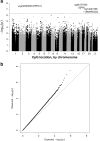Vitamin D, DNA methylation, and breast cancer
- PMID: 29996894
- PMCID: PMC6042268
- DOI: 10.1186/s13058-018-0994-y
Vitamin D, DNA methylation, and breast cancer
Abstract
Background: Vitamin D has anticarcinogenic and immune-related properties and may protect against some diseases, including breast cancer. Vitamin D affects gene transcription and may influence DNA methylation.
Methods: We studied the relationships between serum vitamin D, DNA methylation, and breast cancer using a case-cohort sample (1070 cases, 1277 in subcohort) of non-Hispanic white women. For our primary analysis, we used robust linear regression to examine the association between serum 25-hydroxyvitamin D (25(OH)D) and methylation within a random sample of the cohort ("subcohort"). We focused on 198 CpGs in or near seven vitamin D-related genes. For these 198 candidate CpG loci, we also examined how multiplicative interactions between methylation and 25(OH)D were associated with breast cancer risk. This was done using Cox proportional hazards models and the full case-cohort sample. We additionally conducted an exploratory epigenome-wide association study (EWAS) of the association between 25(OH)D and DNA methylation in the subcohort.
Results: Of the CpGs in vitamin D-related genes, cg21201924 (RXRA) had the lowest p value for association with 25(OH)D (p = 0.0004). Twenty-two other candidate CpGs were associated with 25(OH)D (p < 0.05; RXRA, NADSYN1/DHCR7, GC, or CYP27B1). We observed an interaction between 25(OH)D and methylation at cg21201924 in relation to breast cancer risk (ratio of hazard ratios = 1.22, 95% confidence interval 1.10-1.34; p = 7 × 10-5), indicating a larger methylation-breast cancer hazard ratio in those with high serum 25(OH)D concentrations. We also observed statistically significant (p < 0.05) interactions for six other RXRA CpGs and CpGs in CYP24A1, CYP27B1, NADSYN1/DHCR7, and VDR. In the EWAS of the subcohort, 25(OH)D was associated (q < 0.05) with methylation at cg24350360 (EPHX1; p = 3.4 × 10-8), cg06177555 (SPN; p = 9.8 × 10-8), and cg13243168 (SMARCD2; p = 2.9 × 10-7).
Conclusions: 25(OH)D concentrations were associated with DNA methylation of CpGs in several vitamin D-related genes, with potential links to immune function-related genes. Methylation of CpGs in vitamin D-related genes may interact with 25(OH)D to affect the risk of breast cancer.
Keywords: 25-Hydroxyvitamin D; Breast cancer; DNA methylation; Epigenome-wide association study; Vitamin D.
Conflict of interest statement
Ethics approval and consent to participate
All women provided written informed consent and the study was approved by the institutional review boards of the National Institute of Environmental Health Sciences and the Copernicus Group.
Consent for publication
Not applicable
Competing interests
The authors declare that they have no competing interests.
Publisher’s Note
Springer Nature remains neutral with regard to jurisdictional claims in published maps and institutional affiliations.
Figures



References
Publication types
MeSH terms
Substances
Grants and funding
LinkOut - more resources
Full Text Sources
Other Literature Sources
Medical
Miscellaneous

